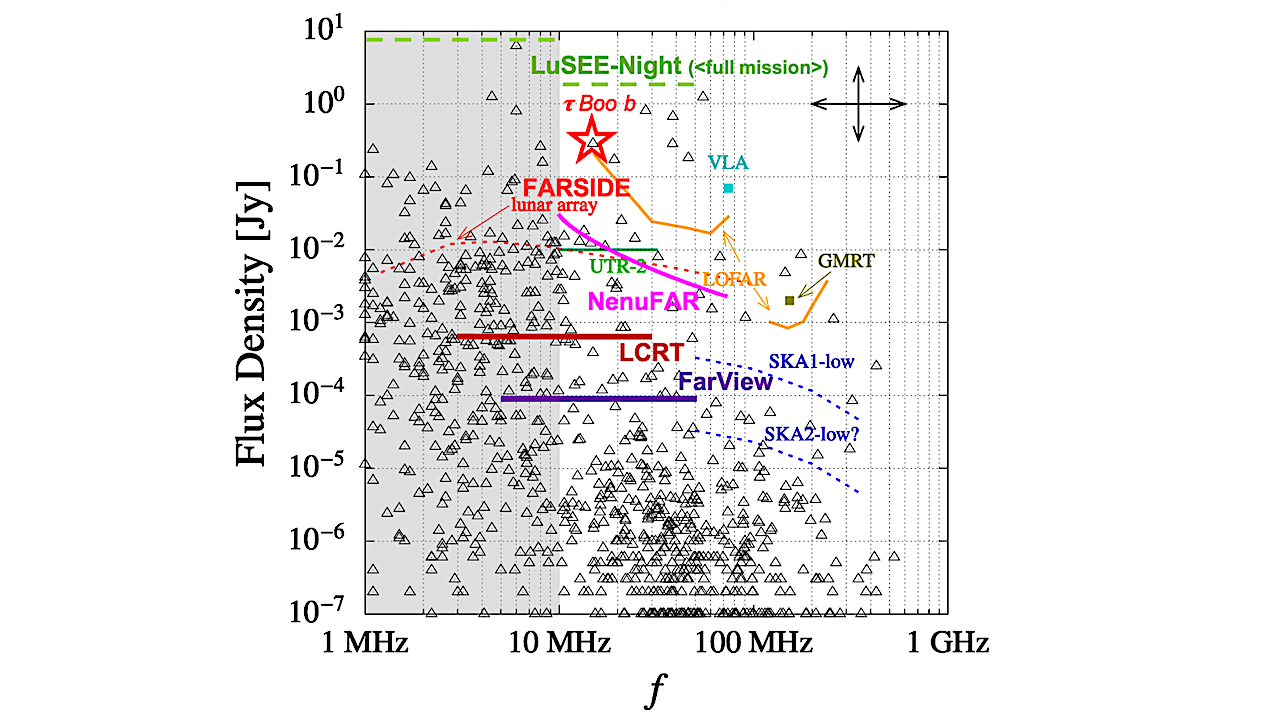Maximum predicted emission frequency and radio flux density for known exoplanets (triangle symbols; data from [8]). The uncertainties on the predictions are estimated to one order of magnitude for the flux density and a factor of 2-3 for the emission frequency12. The sensitivities for the ground-based (UTR-2, LOFAR, NenuFAR, SKA-Low, VLA, GMRT) and space-based (FARSIDE, LCRT, FARVIEW ) radio telescopes are labeled (for 10 min of integration time and a bandwidth of 24 MHz). The FARVIEW and LCRT sensitivity curves are taken from [19] and [2], respectively. The LuSEE-Night sensitivity curve is averaged over the entire two-year mission and includes post-processing using a LombScargle periodogram (see text for details). The possible detection of τ Boo b from LOFAR23 is shown as a red star. This figure is adapted from [9]. — astro-ph.IM
Exoplanets with and without a magnetic field are predicted to form, behave, and evolve very differently.
Therefore, there is great need to directly constrain these fields to holistically understand the properties of exoplanets including their potential habitability. This goal aligns with the Astro2020 Decadal Survey recommendations.
Observing planetary auroral radio emissions is among the most promising detection methods, but decades of searching have yet to yield a conclusive detection, though promising hints are now emerging from ground-based radio telescopes. However, these ground-based efforts are fundamentally limited by Earth’s ionosphere, which blocks the low-frequency signals (<10 MHz) expected from terrestrial and Neptune-like exoplanets.
In this white paper, we outline a strategy to overcome this barrier by utilizing the unique environment of the Moon. We discuss how the upcoming LuSEE-Night and ROLSES pathfinder missions will study our Solar System’s planets as exoplanet analogs and place the first meaningful upper limits on exoplanetary radio flux below 10 MHz.
Furthermore, we explore the revolutionary potential of the proposed future lunar arrays FarView and FARSIDE. For example, FarView will be sensitive enough to study the magnetic fields of a diverse set of exoplanets (super-Earths to gas giants) and an order of magnitude more Jupiter-like planets than ground-based telescopes, providing crucial tests for dynamo theory.
Most significantly, FARSIDE will be able to detect the magnetospheres of nearby terrestrial exoplanets, offering a powerful synergy with atmospheric characterization efforts by JWST and HWO to fully assess their potential habitability.
By opening this unexplored low-frequency window, radio astronomy from the Moon is poised to transform the field of exoplanet magnetospheric science. [Abridged]
Jake D. Turner, Jack O. Burns, David Rapetti, Philippe Zarka, Jean-Mathias Grießmeier, Judd Bowman, Gregg Hallinan, Joshua Hibbard, Johnny Dorigo Jones, Laurent Lamy, Corentin K. Louis, Richard Lovelace, Nivedita Mahesh, Ronald Polidan, Xiang Zhang
Comments: 2 pages, 2 figures. White paper submission to the “Key Non-Polar Destinations Across the Moon to Address Decadal-level Science Objectives with Human Explorers” input call
Subjects: Instrumentation and Methods for Astrophysics (astro-ph.IM); Earth and Planetary Astrophysics (astro-ph.EP)
Cite as: arXiv:2508.09222 [astro-ph.IM] (or arXiv:2508.09222v1 [astro-ph.IM] for this version)
https://doi.org/10.48550/arXiv.2508.09222
Focus to learn more
Submission history
From: Jake Turner
[v1] Mon, 11 Aug 2025 21:51:36 UTC (857 KB)
https://arxiv.org/abs/2508.09222
Astrobiology,
